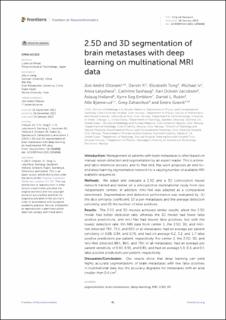2.5D and 3D segmentation of brain metastases with deep learning on multinational MRI data
| dc.contributor.author | Ottesen, Jon André | |
| dc.contributor.author | Yi, Darvin | |
| dc.contributor.author | Tong, Elizabeth | |
| dc.contributor.author | Iv, Michael | |
| dc.contributor.author | Latysheva, Anna | |
| dc.contributor.author | Saxhaug, Cathrine | |
| dc.contributor.author | Jacobsen, Kari Dolven | |
| dc.contributor.author | Helland, Åslaug | |
| dc.contributor.author | Emblem, Kyrre E | |
| dc.contributor.author | Rubin, Daniel L. | |
| dc.contributor.author | Bjørnerud, Atle | |
| dc.contributor.author | Zaharchuk, Greg | |
| dc.contributor.author | Grøvik, Endre | |
| dc.date.accessioned | 2023-10-23T14:13:48Z | |
| dc.date.available | 2023-10-23T14:13:48Z | |
| dc.date.created | 2023-02-19T11:45:11Z | |
| dc.date.issued | 2023 | |
| dc.identifier.citation | Frontiers in Neuroinformatics. 2023, 16 1-12. | en_US |
| dc.identifier.issn | 1662-5196 | |
| dc.identifier.uri | https://hdl.handle.net/11250/3098179 | |
| dc.description.abstract | Introduction: Management of patients with brain metastases is often based on manual lesion detection and segmentation by an expert reader. This is a time- and labor-intensive process, and to that end, this work proposes an end-to-end deep learning segmentation network for a varying number of available MRI available sequences. Methods: We adapt and evaluate a 2.5D and a 3D convolution neural network trained and tested on a retrospective multinational study from two independent centers, in addition, nnU-Net was adapted as a comparative benchmark. Segmentation and detection performance was evaluated by: (1) the dice similarity coefficient, (2) a per-metastases and the average detection sensitivity, and (3) the number of false positives. Results: The 2.5D and 3D models achieved similar results, albeit the 2.5D model had better detection rate, whereas the 3D model had fewer false positive predictions, and nnU-Net had fewest false positives, but with the lowest detection rate. On MRI data from center 1, the 2.5D, 3D, and nnU-Net detected 79%, 71%, and 65% of all metastases; had an average per patient sensitivity of 0.88, 0.84, and 0.76; and had on average 6.2, 3.2, and 1.7 false positive predictions per patient, respectively. For center 2, the 2.5D, 3D, and nnU-Net detected 88%, 86%, and 78% of all metastases; had an average per patient sensitivity of 0.92, 0.91, and 0.85; and had on average 1.0, 0.4, and 0.1 false positive predictions per patient, respectively. Discussion/Conclusion: Our results show that deep learning can yield highly accurate segmentations of brain metastases with few false positives in multinational data, but the accuracy degrades for metastases with an area smaller than 0.4 cm2. | en_US |
| dc.language.iso | eng | en_US |
| dc.publisher | Frontiers Media | en_US |
| dc.relation.uri | https://www.frontiersin.org/articles/10.3389/fninf.2022.1056068/full | |
| dc.rights | Navngivelse 4.0 Internasjonal | * |
| dc.rights.uri | http://creativecommons.org/licenses/by/4.0/deed.no | * |
| dc.title | 2.5D and 3D segmentation of brain metastases with deep learning on multinational MRI data | en_US |
| dc.title.alternative | 2.5D and 3D segmentation of brain metastases with deep learning on multinational MRI data | en_US |
| dc.type | Peer reviewed | en_US |
| dc.type | Journal article | en_US |
| dc.description.version | publishedVersion | en_US |
| dc.source.pagenumber | 1-12 | en_US |
| dc.source.volume | 16 | en_US |
| dc.source.journal | Frontiers in Neuroinformatics | en_US |
| dc.identifier.doi | 10.3389/fninf.2022.1056068 | |
| dc.identifier.cristin | 2127276 | |
| cristin.ispublished | true | |
| cristin.fulltext | original | |
| cristin.qualitycode | 1 |
Tilhørende fil(er)
Denne innførselen finnes i følgende samling(er)
-
Institutt for fysikk [2695]
-
Publikasjoner fra CRIStin - NTNU [38127]

